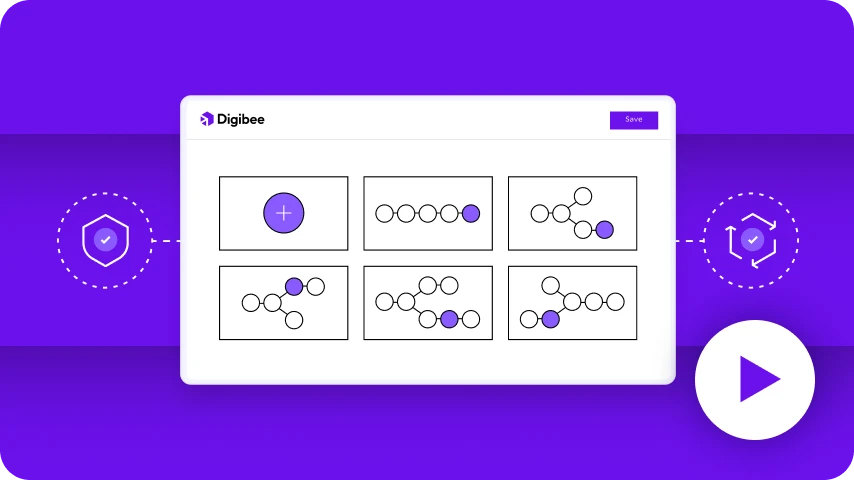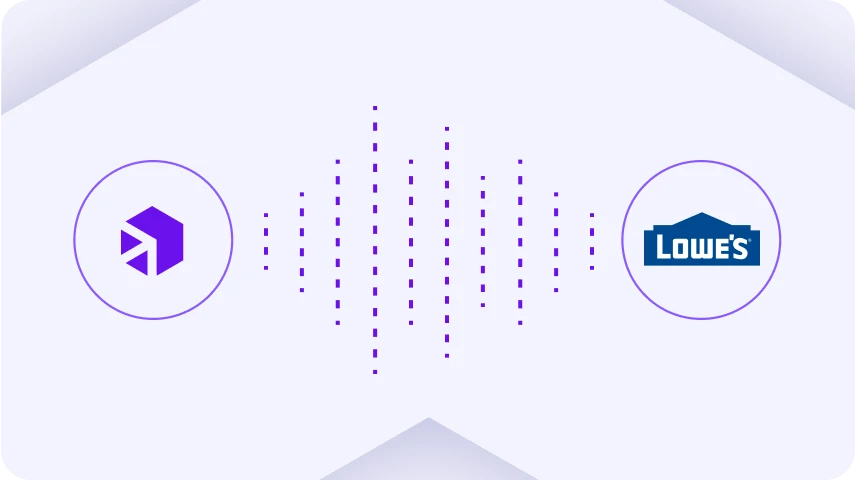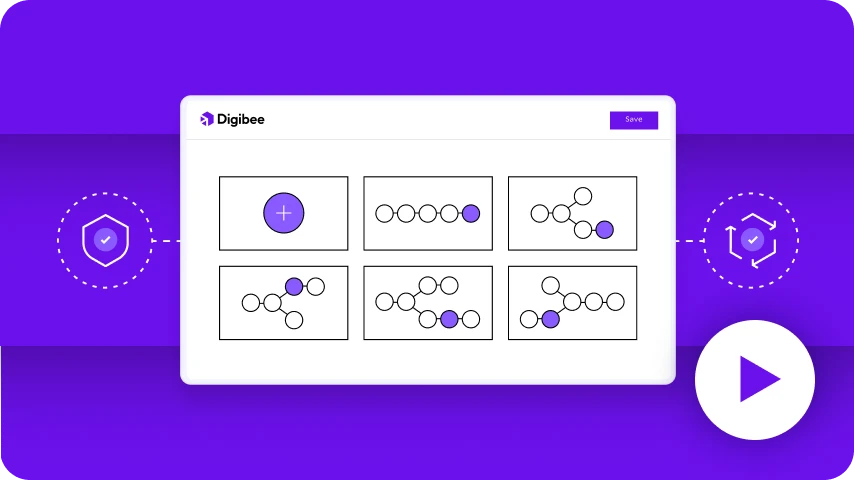
Learn how Digibee’s iPaaS is changing the way the world thinks about integrations – transforming processes and maximizing developers innovative work.

Learn how Digibee’s iPaaS is changing the way the world thinks about integrations – transforming processes and maximizing developers innovative work.

Interview with Duncan McFadden, enterprise platform support for ServiceNow at Lowe’s, discussing how Digibee’s iPaaS transformed their shipping logistics.
In this episode of “Integration. Redesigned.,” our host, Digibee’s Chief Marketing Officer Cait Porte, interviewed Duncan McFadden, enterprise platform support for ServiceNow at Lowe’s (sometimes incorrectly referred to as Lowes), to discuss how Digibee’s iPaaS transformed their shipping logistics. By partnering with Digibee and implementing a modern shipping integration solution, Lowe’s saw improvements in error monitoring, logging, and email notifications, resulting overall in better performance and reduced manual efforts. Duncan also expressed his intention to utilize Digibee for future projects, particularly in inventory and asset management, which are crucial aspects of Lowe’s operations.
Ease retail supply chain uncertainty through better integration
This quick guide for retail businesses highlights how Digibee’s platform helps customers mitigate supply chain and operations risks, improving integrations with customers and suppliers.
Compelling Case Studies
Our customers experience digital transformation up to 70% faster with less cost. These compelling case studies highlight how we lead our customers to successful and efficient solutions.
Understanding iPaaS
Helpful guide to understanding what an integration platform as a service (iPaaS) is: how they work, what they do, and the benefits. While iPaaS use cases and benefits are compelling, not all iPaaS solutions are the same.
CAIT PORTE:
Hello and welcome back to integration. Redesigned. I’m your host, Cait Porte, and in this episode,I am joined by Duncan from Lowe’s. Duncan, welcome.
DUNCAN McFADDEN:
Thank you, guys.
CAIT PORTE:
Duncan, we’ve worked together now with Lowe’s for a little while. Why don’t you tell everybody what your role there is over at Lowe’s?
DUNCAN McFADDEN:
So. My name is Duncan McFadden. I handle enterprise platform support for ServiceNow. I’ve been doing it for roughly four to five years now. Whether it’s been from just handling enhancements and defects to now more handling the actual platform itself from like, license structure, platform upgrades, and all that kind of support.
CAIT PORTE:
So Duncan, thank you for joining us. Tell me what prompted Lowe’s, when you think about how Lowe’s is working with ServiceNow and integration, but what prompted you to look for an integration solution?
DUNCAN McFADDEN:
So at the time, we were just about to start working a defect related to all of our shipping integrations, where a lot of stuff was just getting like, random errors. At the time, we weren’t really logging anything just because we had nothing really set up from IT, at least from that background. Honestly, we weren’t really looking for an integration solution. It just happened to be due to the friendship of other individuals that they started working for Digibee. And we were able to look at that solution holistically and start to work something together.
CAIT PORTE:
So tell me a little bit more about this shipping situation. We know that Lowe’s provides amazing customer service. I’m a Lowe’s customer. There’s one around the corner that I hate to admit that I frequent so often. We’re always doing home projects, but when you think about this from a consumer standpoint, obviously we care about shipping notifications, but was there an impact to consumer behavior here or was this primarily internal logistics? What was going on?
DUNCAN McFADDEN:
So this would be just internal logistics. Related to movement of IT equipment. So when you think about, let’s say, like, the phones, like, your signature captures that obviously you’re doing your payment methods through, any of those kind of items where we’re moving stuff. It’s a different FedEx account than what you’d see from like a consumer level. So, we’re just not sure if there was like a disconnect there. But we were using kind of like. An old version of their integrations, which was like soap based. Granted, again, it was built in 2017, but obviously Digibee was able to help us move to a more modern solution of the shipping integration.
CAIT PORTE:
It’s interesting to hear 2017 referenced as, like, a long time ago, but you think about technology changing every day and new things coming out. We want to have our companies on the latest and greatest of technologies without the legacy holding us back. When you think about before and after and what the outcome was in using Digibee to power these integrations, what are you seeing now as a result of that implementation?
DUNCAN McFADDEN:
So, I think in the past we could say there was at least a 5% to 10% plus disconnect when it comes to sometimes showing like delivered statuses. Sometimes, I mean, the status would not even show anything. It would just show that the tracking was just sitting there, doing nothing. One, we’re seeing those, from like a logging perspective a lot better, because obviously you can see logs tremendously better when it comes to Digibee’s platform. As well as making sure we know that those alerts are happening. So obviously all that stuff is being sent back to our platform and we’re able to see some of that stuff through email notifications. It does seem that we’re getting a better, or at least a lower rate, of issues. I would still say there’s probably like a 2% when it comes to – but I want to say this is more like a FedEx-related question. But yeah, it’s definitely working a lot better. Again, obviously to speed to market of not having to do some of these extra logging tables and doing some of that extra work just to be done from our side was nice. And yeah, I mean, the tool is really easy to show someone what’s going on.
CAIT PORTE:
I love there were two things that you referenced there. One of the things that we talk about is the ability to drive down your backlog. So Duncan, has there been anything that you’ve been able to see as an output now that you’re no longer worried about this shipping situation where, “hey, yeah, those notifications are going out, we’re not seeing as many errors. I don’t have to react to feedback or questions or monitoring or issues.”
Is there anything now that you’re able to get to as a result? Has that been something that’s come as a result?
DUNCAN McFADDEN:
Yes! So, while we were working this with you guys, I was actually doing some other enhancements when it came to some parts of shipping and receiving. And I guess an example would be at the time someone had to manually receive stuff, right. Because we’re concerned with obviously that delivered status being correct at the time with the old integration. So, someone was manually receiving product to actually show the movement of assets to the stores. So, obviously this is more like a holistic asset management approach. But, with that, right, now that we know that the delivered
status is a little bit more refined and able to be known that it’s correct, we moved everything to be back to automatic receiving. So, obviously you’re taking – I think we took about three users off of manually receiving stuff. When you look at the hours of time spent per year, something like they were wasting probably like $15K-$18K on it per year. I mean, granted, this is just hour based, but that alone, right? I mean, that speaks volumes. How quick – while you guys were doing the integration, I’m obviously doing other work and we’re able to just push out more stuff together that way.
CAIT PORTE:
Yeah, I’ve talked about this a lot on the podcast is my background is in product and product management, and so I have a soft spot for the ability to get more work done, particularly for development, because you can then say, “hey, we’re going to focus on these really crucial, more innovative things, so that’s because we have this ability unlocked,” right? So it’s not to say you no longer need those three individuals or that your time is no longer needed related to this integration, you just can now focus those resources on other more crucial things. It sounds like.
You also mentioned that the platform allows for more visibility. Can you tell me about what you’re showing and who you’re showing it to? You referenced that earlier.
DUNCAN McFADDEN:
Yeah. So currently it’s really more like a reference point to only me and one other individual, but it’s more just being able to see those logs. With a lot of your more traditional, say, like, platforms as a service, you’re not going to have that much built when it comes to logging, out of the box. Without having to really stand up a good enterprise logging solution at that point. And then obviously, you run into a lot of factors of how big those tables become? How do we make sure security around some
of that stuff? So, actually just having it within Digibee and being able to see it easily and quickly for whatever request I want to look at does make things a lot easier. Right? Because obviously we know where the errors are. They’re going to be bucketed to wherever they are, and then we can just work to fix those issues really quickly.
CAIT PORTE:
Duncan, you’re referencing a number of things that we’ve talked about.
Has the ability or the usage of Digibee now highlighted, “hey, I can use this in other areas?” Are there things where you’re saying, “hey, there’s this opportunity that exists at Lowe’s, or I see this challenge, or this problem, or this service is falling down where I can now insert Digibee?”
And maybe you can talk a little bit about what you’ve seen as a result of the ease of use that we’ve talked about so far.
DUNCAN McFADDEN:
Oh, definitely! From our side, right, we’re just kind of on a hold when it comes to some integrations. But, I definitely will be using Digibee for the future. I could definitely say we’re going to be working on a pretty big project here soon related to some other kind of forms of inventory and asset management. But, when you think about inventory and asset management, that spans very large. When it comes to Lowe’s, and I mean all companies, right, they’re going to care about their inventory and asset management a lot.
CAIT PORTE:
Inventory and asset management not only matters for the consumer, matters for the business. What do we have? How much room do we have? How do we think about what’s coming in and what’s going out? Especially when you’re talking about big physical products used for home improvement. So, all that space really matters when it comes to laying out your store, thinking about your trucking, and anything that’s getting from point A to point B being available for the consumer. So, I could imagine that there’s a ton on your plate, potentially, for how can I use this technology to improve some of that or to optimize what we’re doing today?
DUNCAN McFADDEN:
Absolutely. Yeah. There’s such small things that most people don’t think about asset management that it adds up really quickly. When you start looking at like, dollar amounts, it’s very crucial to keep it in check, I’ve learned.
CAIT PORTE:
Are you looking at a lot of the dollar amounts related to the work that you’re doing or having an impact on? Is that a part of your role?
DUNCAN McFADDEN:
It is now, yes. We are looking to kind of watch what’s the difference between efficiency gains or if we can kind of move some of our – because we track, obviously, the amount of hours for certain work – so we’re going to track against efficiency gain, whatever, like CPECs and OPECs for a lot of stuff. So, it is a very big thing to my new team. I will say that at least the ServiceNow space has moved around to different departments and now it is kind of like a bigger focus.
CAIT PORTE:
Did you look at any other iPaaS solutions as you were evaluating and trying to solve this problem?
DUNCAN McFADDEN:
I personally did not. I, again, was very trusting of the individuals that I did work with with Digibee, and did take everything from what they said. And I mean, it worked exactly as we wanted, so there’s really no real reason to look for a different solution at the time.
CAIT PORTE:
Well, we love to hear that, right? We’re very happy that Digibee is having an impact on what you’re doing at the business. Duncan, thank you so much for spending time with me today.
For everyone joining us, thank you so much for joining. It’s been a pleasure. Again, my name is Cait. This is integration. Redesigned. Brought to you by Digibee. And thanks for joining me.

Digibee surveyed over 1k enterprise IT professionals to provide insights into their integration patterns, challenges, and opportunities. Here’s what we found.

Discussion with a sales team member highlighting the challenges IT departments face on their journey to integration and Digibee’s people-centric approach.

With host Cait Porte, Chief Marketing Officer at Digibee
In this episode of “Integration. Redesigned.,” our host, Digibee’s Chief Marketing Officer Cait Porte, is joined by Field Chief Technology Officer for Latin America, Andre Campos, for a discussion exploring IT departments. Cait and Andre cover topics including how IT departments have evolved, building them, the current perceptions around them, the challenges they face and ways to overcome those challenges, the importance of collaboration between IT and other departments, and the crucial role these departments can play to deliver significant value to their company. One perception in particular discussed is the significant expense of IT for companies while IT struggles to demonstrate their value. Cait and Andre cover how prioritizing IT departments to drive digital transformation efforts can become a competitive advantage for businesses.
CAIT PORTE:
Welcome back to another episode. I’m Cait Porte, your host. And today we are talking with our Digibee Field CTO for Latin America, Andre Campos. Welcome, Andre.
ANDRE CAMPOS:
Hi Cait. It’s good to be here again.
CAIT PORTE:
Thank you for joining us.
Very excited about the topic today, which is building an IT department and why that is seen as such a huge expense for a company. I think I may know the headline here, but very happy to have you to talk about this.
I think we’ve talked about digital transformation a number of times on the podcast and I think we will continue to do that. When we think about digital transformation, it’s a necessary evil, as we say, because we have to do this – IT teams and departments and all of the technology we have available relevant – and it’s expensive and takes longer typically than you expect, creating some frustration between everyone working on anything related to digital transformation and trying to limit the amount of cross-functional frustration that happens. Right?
Rodrigo talked about how IT departments have lost a little bit of credibility even though they’re so crucial, now more than ever. So why is this the case at some companies? From your experience and past life, what are you seeing? Why are we seeing such a friction between the necessary evil of getting them and where there’s an expense?
ANDRE CAMPOS:
I think that we are in a changing period. If you go back in history 20 years ago and thinking about history 20 years is not so. That time, IT was responsible for support business and to keep everything up and running. And every new project took a lot of time and was hard to implement. Everything was manual, and was hard to meet business expectations because of the lack of technology, the lack of understanding. There was not much partners to work together to deliver what was expected. And I think that the combination of everything has created the bad reputation of IT and it’s been hard to change it through the years. It’s been changing, but we are in the middle of this change.
CAIT PORTE:
I love that and I think we’re trying to shift the tide, right? And we’re trying to change that perspective or perception of IT.
When we think about where we are, what do you see as maybe the top challenge that IT departments are faced with in trying to get the support that they need to deliver?
ANDRE CAMPOS:
I think that we have to always remember that transformation is not about technology, it’s about people. It’s not about how technology will think, will change everything, but how people will use technology to change everything. I know it’s not that strong, but it’s different. So, how are you going to use the right technology, the right partners, to help people changing their daily basis work? Or help people changing the relationship they have with their customers or the other business that are partners? So handling it, thinking about the business need as the center of everything is key to change and to accelerate the digital transformation.
CAIT PORTE:
I agree with that being on the receiving end of digital transformation in the past. But, for a company that doesn’t see IT as a default department sort of just say “yes, we have to have this, because…” When a business isn’t built on technology, how do companies, in your opinion, approach technology, digital transformation, with a mindset that it is a competitive advantage, not just another expense?
ANDRE CAMPOS:
I think it is a matter of natural selection. All the companies that – well we are in the moment that we are having changings in the customer behaviors, in the relation between business to business – so there is a lot of things that has to be changed. So, if the company doesn’t face it as something that will make the business better, more performative to match customer expectations, it will be something that will leave them behind the others. They don’t want to create a differentiator, they’ll just be another company and the customer will definitely select another provider. So, it’s key to start this transformation.
CAIT PORTE:
Interesting comment there. And I think many companies are faced with is it the people, is it the technology? Is it a mindset shift that we move toward? And, what is going to impact the bottom line? So when you look at those things – I mean, you already mentioned people, you already mentioned that you can’t just get technology – what would you give as a recommendation for other teams to say hey, let’s get it to perform at its best? And, to deliver the most for the company?
ANDRE CAMPOS:
I think that this evolution, this change is happening now. And, I think that is happening in a lot of different dimensions. We have more technology available, so it’s easier and faster to find platforms that can help this process, to find good partners, to help these partners. I think that we, you and me, we are immersed in a lot of technology. We have smartphones, we see Netflix and streaming and everything. We can have everything faster. So, we now know how technology can help us in our lives. And I think that because of the changes and the need of meet customers expectations to change the way we relate with other business, this pressure is making the business and IT departments work better together. So, it’s been easier to bring IT from the “doer department” to a “strategic department.” This is the right moment to do that.
And, I think that the pandemic has accelerated that. Putting IT in now because of the restrictions we had. IT was the most important part to allow the business to keep running. And, I think that knowing business better, having business and technology working together, this is the most important change to go through the digital transformation.
CAIT PORTE:
I was thinking about this earlier. In past lives I’ve worked in a product capacity, and the most success – and I know that you are coming from a CIO background and experience, right? I’m assuming that you’d echo this – in that the most success that we’ve had is when as a product team, we’ve presented from a business lens to the IT department to say, “hey, this is the challenge we’re trying to solve. Help us figure out how to do that.” As opposed to very prescriptively, “here’s the solution, go get it done.” And I think that has always been the case. But there’s certainly more success when we really involve IT from the beginning in solving a problem and utilizing that skill set.
ANDRE CAMPOS:
Exactly. Yeah, that’s it. My point of view, IT is the most important agent of change. Knowing better the business and knowing technology. And most important than that, knowing how to apply technology in benefit of the business. So having IT involved since the beginning, applying the right technology, having the right partners. This is very important to have success process.
CAIT PORTE:
Absolutely. Well, thank you, Andre, for joining us today. Always a pleasure to have you on. Love to hear the experience about how we can make IT teams look good again, right? And deliver that value.
So thank you for joining us.
ANDRE CAMPOS:
Thank you very much. It was a pleasure.

An examination of the findings of the 2023 SEI report through a retail industry lens.
Digibee surveyed over 1,000 enterprise IT professionals in the first quarter of 2023 to provide insights into integration patterns, challenges, and opportunities in our annual State of Enterprise Integration report.
Retail Integration efforts are leading the industry curve. The report aims to help enterprises understand how you stack up against other industries when it comes to integration – and where you stand compared to your peers.
Ecommerce data management and omnichannel strategy are advancing rapidly in retail. Integration is becoming the industry standard, big data in retail continues to prove vital for growth, and connectivity between ecommerce and physical storefront systems is mission-critical. Retailers who fail to evolve in these trends are falling further behind.
The data speaks for itself. The report illuminates retail industry trends and challenges, including:
Download your copy of the report and benchmark your performance against industry peers.

An examination of the findings of the 2023 SEI report through a finance industry lens.
About the report
Digibee surveyed over 1,000 enterprise IT professionals in the first quarter of 2023 to provide insights into integration patterns, challenges, and opportunities in our annual State of Enterprise Integration report.
Modernizing financial technology solutions is a necessity for an industry long dependent on legacy systems. Data privacy, fragmented systems, security and compliance – there is no shortage of challenges for this industry. Without a truly connected environment, financial organizations are unable to innovate, curtailing their efforts to digitally transform the business and—most importantly, the experiences they deliver to their customers. This report aims to help financial organizations understand how successfully connected operations leads to innovation and improved experiences.
Key highlights from the financial services report
The 2023 State of Enterprise Integration for Finance offers some unexpected revelations about the industry’s progress:
Efficient and effective data management in financial services is vital to success. But integrating new solutions with aging architecture is a challenge – and those unable to evolve are falling further and further behind.
Assess your organization’s state of integration
Download your copy of the report to get industry-specific insights and expert analysis on current integration goals, challenges, and opportunities.

A quick guide for retail businesses looking to take back control to mitigate supply chain and operations risks.
Key highlights from this guide:
Digibee’s integration platform helps retailers quickly transform their integration architecture by enabling seamless connectivity.
Digibee can help you transform your supply chain into a resilient, digitally connected ecosystem. Integration enables real-time, end-to-end visibility, flexibility, and scalability that:
Global food retailer with 12,000+ stores
Restaurant food-chain supplier with 70 facilities in 18 countries
International parcel delivery service
Supermarket chain with 50+ stores

An examination of the findings of the 2023 SEI report through a manufacturing industry lens.
About the report
Digibee surveyed over 1,000 enterprise IT professionals in the first quarter of 2023 to provide insights into integration patterns, challenges, and opportunities in our annual State of Enterprise Integration report.
The manufacturing industry is rapidly transforming and the pressure to catch up and keep up is growing. This report aims to help manufacturers understand how connected operations leads to leveraging innovation to its true potential.
Key highlights from the manufacturing report
The demand for automation and increased security of systems are fueling integration efforts for manufacturing organizations. Manufacturers trapped between what they already have and what they need to have are looking to digitally transform and integrate manufacturing systems to maintain a competitive edge, but challenges persist:
Improved manufacturing data management has become crucial to success, but integrating legacy systems with modern tools can be a daunting task. Companies that cannot evolve risk falling behind their competitors.
Assess your organization’s state of integration
Download your copy of the report to get industry-specific insights and expert analysis on current integration goals, challenges, and opportunities.

The business case for integration has never been stronger. This infographic highlights some of the findings of Digibee’s 2023 State of Enterprise Integration report.

Interview with executive Bob Howland providing insights about leadership and change management from his 20+ years in the e-commerce space.

Insights from enterprise technology leaders and executives on the critical role of system and data integration for businesses competing in a digital-first world.
X